Cactus Soil – The Best Potting Soil Mix for Cactus Plants
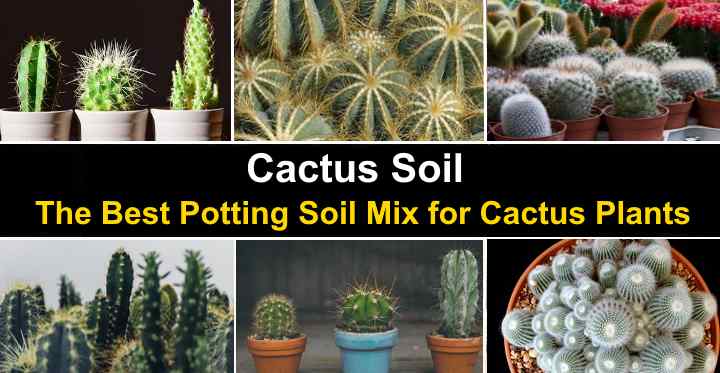
Cactus soil is a combination of organic and inorganic ingredients to create a fast-draining, low-fertile potting mix. The best soil mix for cacti should mostly consists of ingredients like perlite, gravel, grit, or crushed granite to help aerate the soil. Indoor cactus plants need to grow in potting soil mix different from regular houseplant because they need a fast draining soil. It’s straightforward to make cactus soil yourself, and it’s cheaper than buying a commercial cactus potting mix.
The ideal potting medium for cactus plants is similar to succulent potting soil mix but it contains more inorganic matter. A cactus potting mix that is mostly gravel (or grit) with some organic matter allows water to drain fast without staying too wet. Cacti grow outdoors in dry, arid landscapes where there is little moisture so their potting soil should dry quickly.
An aerated, porous potting mix provides excellent drainage for cactus plants to thrive. As long as a cactus potting soil mix drains well, you’ll have few care issues growing cacti—indoors or outdoors.
Cactus plants don’t need many nutrients to grow indoors. So, a cactus potting mix doesn’t require rich organic ingredients such as peat moss, compost, or wood chips. These ingredients also tend to retain too much moisture for cacti, leading to root rot and may kill your fleshy cactus plant.
In this guide, you’ll learn how to make the best cactus soil mix. You’ll also find a handy recipe on how to make cactus soil for your indoor plants.
Why Cactus Needs Special Soil
Cactus plants need particular soil because regular plant soil holds too much moisture. A light, porous potting mix allows the cactus plant roots to absorb the moisture they need without retaining too much moisture. After watering, the excess water should drain away from the cactus soil. This way, the cacti get adequate hydration and avoid rot and fungal diseases.
What Is the Best Type of Soil for Cactus?
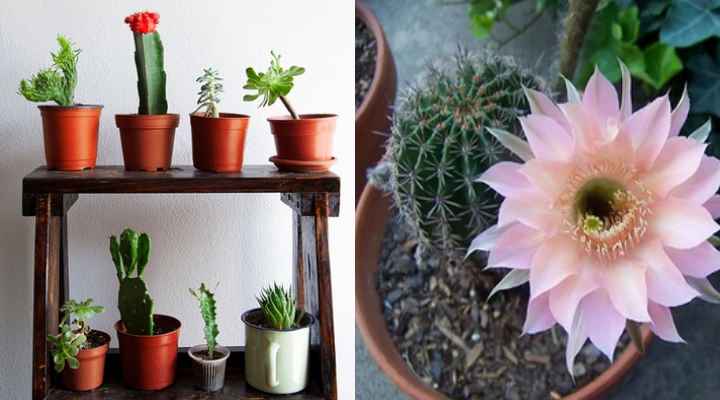
The best cactus soil mix should be well-draining and contain about 2/3 of inorganic matter
The best cactus soil mix should be porous and airy. To make an ideal growing medium for cactus, mix gravel, grit, or similar ingredients with regular potting soil. The best ratio to create a potting mix for cactus or succulents is one-third organic matter (or potting soil which mostly contains organic matter) and two-thirds inorganic matter.
Suitable soil amendments to make your own well-draining cactus soil include small gravel chips, crushed granite, poultry grit, or aquarium gravel. You can also use pumice or perlite because it’s light and porous and excellent for amending cactus potting soil to improve drainage.
Of course, cactus plants—like all plants—need hydration to survive. The best way to water a cactus is to drench the soil and leave it to dry. The ideal cactus potting mix should dry out in a day or two. So, the perfect potting mix should be like that native habitat of cactus plants—dry, desert-like conditions.
For a homemade cactus soil mix, avoid soil amendments such as vermiculite. Although vermiculite helps loosen soil, it retains too much moisture, which is not ideal for growing cactus plants in pots.
Even though cacti grow in sandy deserts, adding sand to a cactus potting mix isn’t ideal. Sand can be too fine for the potting soil and not allow for sufficient drainage. The only type of sand to use would be very coarse horticultural sand. However, grit, gravel, perlite, or crushed stones are a better option for cactus soil.
Why Regular Potting Soil is Bad for Cactus
Regular potting soil is a poor choice for growing cactus because it stays damp too long. Cactus and succulent plants are susceptible to root rot and disease if they grow in too much moisture. Because houseplant potting soil mostly contains moisture-retaining peat, compost, or bark, it’s not great for cactus.
Another reason not to use a regular houseplant potting mix for growing cacti is that it quickly becomes compacted. The dense soil structure takes longer to dry out, and the damp soil starts to rot the cactus roots. What’s more, compacted soil has poor drainage.
If you notice that your cactus potting soil mix is damp for more than a few days, you’ll need to lighten the soil by adding more grit, perlite, or gravel.
The Best Cactus Soil
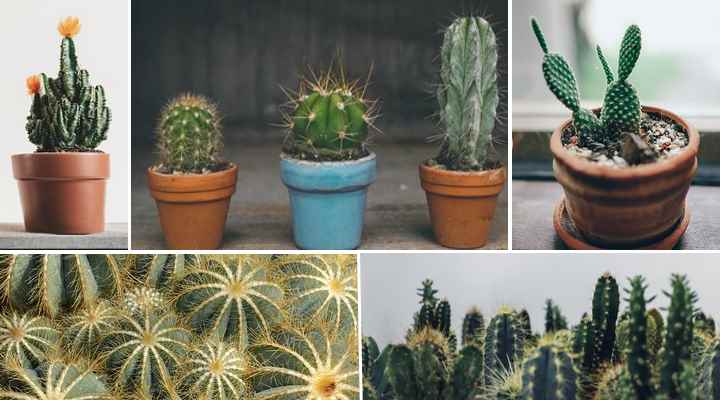
For DIY cactus soil mix 1/3 peat moss, bark chips or compost (organic matter) with 2/3 of perlite, pumice, gravel or other inorganic matter
The best potting soil mix for cactus plants is a mixture of two-thirds inorganic matter and one-third organic ingredients. To make the perfect cactus soil, start with regular potting soil which contains mostly organic matter. Then add grit and perlite for drainage and aeration to create an ideal growing medium for cacti.
Using some organic matter—peat moss or compost—is required for cactus potting soil, as a small amount of organic material retains just enough moisture to hydrate the plant’s root—but not so much that it becomes soggy.
Organic ingredients contain nutrients that are good for cactus and succulent plant growth. But remember that peat and compost take a longer time to dry, and dampness can kill cactus plants.
You can quickly turn regular potting soil into a suitable potting mix for growing succulents or cacti. Amend the soil with gravel, perlite, pumice, grit, or small stones to improve drainage and allow for faster moisture evaporation.
Common Ingredients in DIY Cactus Soil Mix
The best cactus soil mix has regular potting soil mixed in with large proportions of gravel, grit, and pumice. For a homemade cactus soil mix, use proportions of 2 parts inorganic matter to 1 part organic material. Using this combination of ingredients creates the ideal medium for growing cactus plants.
Let’s look in detail at why the ideal cactus potting mix needs plenty of gravel and perlite and less organic matter.
Here are the ingredients in the DIY cactus soil:
Regular potting soil
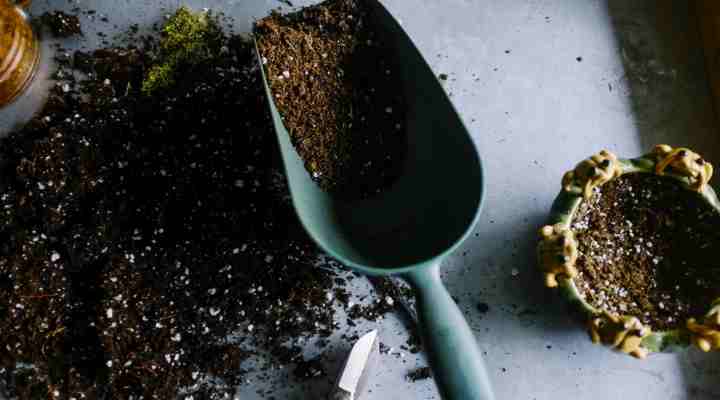
Regular potting mix is one of the ingredients in the DIY cactus potting soil
All-purpose, regular potting soil is the base for most homemade cactus soil mixes. The soil for your potting mix should be sterile and fresh. The organic matter holds enough moisture for the cactus roots to absorb. And it should dry out quickly to prevent root decay and damage.
When choosing the right potting soil, don’t take earth from the garden. Backyard soil may contain pests, bugs, disease, or have other problems. You don’t want to introduce houseplant pests such as mites or gnats into your home where they could infest your other houseplants.
To make a cactus potting mix at home, start with regular potting soil for your base. Then add coarse ingredients such as grit, gravel, or perlite to create a perfect cactus soil with excellent drainage.
Perlite or pumice
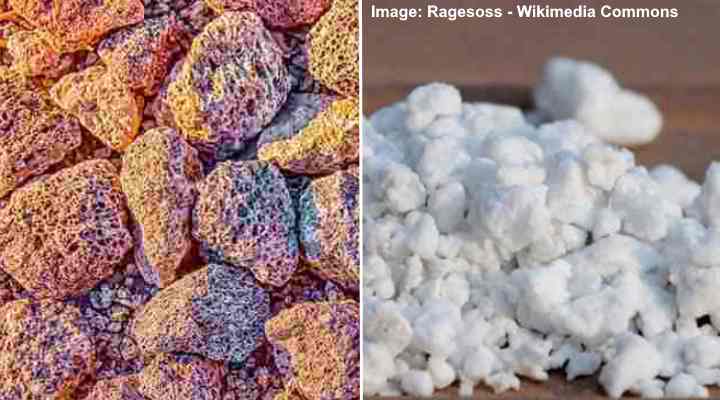
Pumice (left) and perlite (right)
Perlite is a naturally occurring mineral that is a common soil amendment. Perlite benefits cactus soil because it’s porous, light, and airy. The small white mineral pieces create space in the potting mix, allowing better airflow, drainage, and root growth.
Perlite is a type of volcanic substance and has the appearance of small Styrofoam balls. During the production process, the perlite gravel is heated to enormous temperatures where it puffs up like popcorn. During the processing, no chemical or synthetic materials are used. So, perlite is ideal for organic gardening.
Pumice is another volcanic substance that is ideal for use in a cactus soil mix. Up close, small pumice pieces have a porous look due to hundreds of tiny holes. Amending potting soil with pumice also helps to create a well-draining mix for desert plants, cacti, or succulents to grow. Like perlite, pumice makes an aerated potting mix with excellent drainage.
Comparing the two types of soil amendment, perlite is more popular than pumice for a cactus soil mix. Generally, perlite is cheaper than pumice and is easier to find in garden stores.
Gravel or grit
Grit or gravel is the other essential ingredient in a well-draining cactus potting mix. You can also add soil amendments such as poultry grit, aquarium gravel, crushed limestone, or granite pieces. Ideally, you can add any inorganic substance if it doesn’t hold water and creates an aerated soil.
It is possible to use coarse horticultural sand in your cactus potting mix. Stay away from sand from the beach or a sandbox. Beach sand is too fine to create a suitable draining potting soil. It can also contain bugs and other nasties that can infest your cacti and succulents.
Most garden centers, home improvement stores, DIY stores, or online shops sell gravel or grit suitable for making a cactus potting mix.
How to Make Cactus Soil Mix
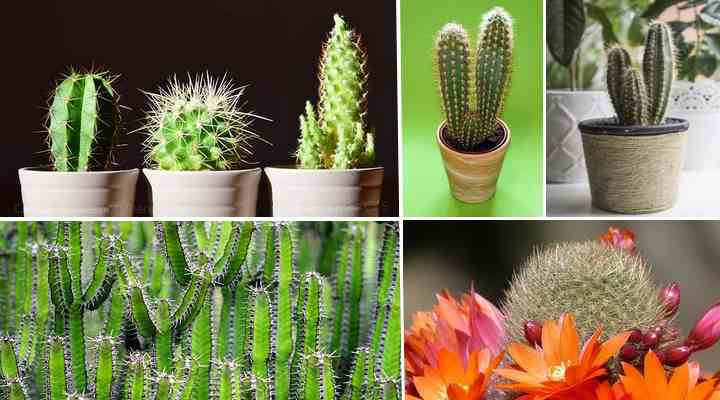
Making your own cactus soil mix ensures your cacti get enough nutrients while the soil is well-draining
To make the cactus soil, mix gravel, perlite, and regular potting soil. The proportions for creating the ideal potting mix for cactus are 2/3 inorganic matter (such as gravel and perlite) and 1/3 organic matter (such potting soil mix).
Here is the recipe for a homemade cactus potting soil mix:
- 1 part regular potting soil
- 1 part perlite
- 1 part grit or coarse gravel
You can amend this cactus soil for growing succulent plants. If you want to make a soil mix for succulents, use 1 part perlite and 1 part coarse sand to 2 parts regular potting soil. This light, sandy potting mix has excellent drainage and is best for succulents.
How to mix potting soil for growing cactus plants
To make a homemade cactus soil mix, put all your ingredients into a large bucket. Using a trowel, mix the three components—the soil/organic matter, perlite, and grit—until it’s well combined. Once the soil is evenly mixed, you’re ready to plant your cactus plants in pots or your yard.
Outdoor Soil for Cacti
Soil requirements for planting cacti outdoors are the same for potting soil mixes. Cactus plants growing in the ground need a light, porous medium that is mostly gravel or small stones. However, the growing conditions for cacti outside mean that soil doesn’t need ideal drainage.
Outdoor cactus plants generally get more sunlight and airflow than potted, indoor cacti. This means that moisture in the soil evaporates faster. Also, the increased volume of soil to plants means that drainage issues affect outdoor cactus plants less.
The best way to grow cactus plants outdoors is in raised rock gardens. The rocky soil allows water to drain fast, and the raised berm or succulent garden doesn’t allow water to gather around the roots.
The other way to amend backyard soil for growing cactus outdoors is to work in plenty of grit or gravel to your cactus garden. Ensure the cactus plants are growing in full sun, and that water drains away from the cactus bed.
If you live in colder climates, you can grow cacti in pots outdoors during the summer. Then in the fall, when the temperature drops, bring the cactus pots indoors and place them in a sunny location.
The Best Potting Soil Mix for Cactus to Purchase
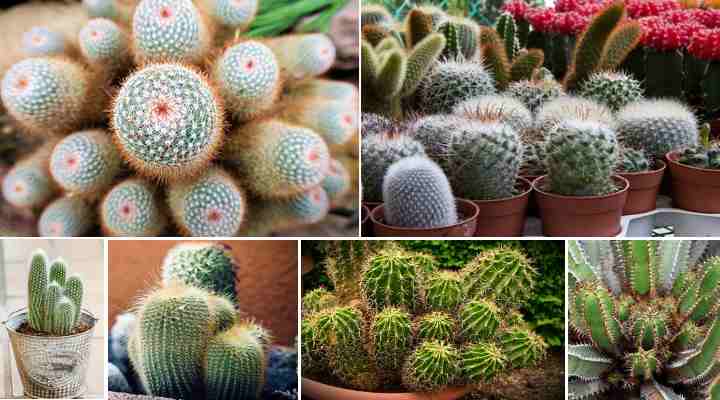
If you don’t want to make your own DIY cactus potting mix, you can buy ready-made cactus soil
You can buy a commercial cactus potting soil mix if you don’t want to make a homemade one. Commercially-produced cactus mix packets contain the essential components of organic material and inorganic drainage amendments.
Here are three examples of cactus soil mix you can buy:
Sun Gro Horticulture Cactus Mix — This cactus soil mix contains forest humus, perlite, sand, and pumice. The blended soil is not too rich for cactus plants, and the inorganic matter gives excellent drainage.
Fast Draining Soil Mix for Cactus — This soil for cactus is light-weight and well-draining and ideal for any kind of cactus. The soil mix is a blend of substrate and perlite with low fertilizer content.
Bonsai Jack — This gritty soil mix is ideal for growing cactus plants indoors due to the large pieces of calcined clay and fine bark bits. The excellent drainage in this cactus and bonsai mix means it’s almost impossible to over-water your cactus.
How to Choose the Best Pots for Cactus
The best cactus pots are made from terracotta and have drainage holes. Holes in the pot’s base allow excess water to drain freely through the bottom when you soak the soil. To make an ideal cactus pot, drill a hole in the bottom if there’s not one already.
Here are ways to choose the ideal pot for growing cactus plants:
Terracotta or unglazed clay pots are ideal for growing cactus plants. Terracotta pots are porous and allow the cactus soil to breathe. Also, it’s easier to regulate soil moisture with unglazed clay pots as water evaporates faster.
Glazed ceramic pots hold in more moisture than terracotta pots. Generally, you need to water cactus plants less often when they’re growing in glazed pots.
Plastic pots are the cheapest options for growing cacti. Similar to glazed pots, plastic ones hold more moisture in the soil. So, always check the soil for dryness before watering your cactus plant.
How to Plant a Cactus in a New Potting Soil Mix
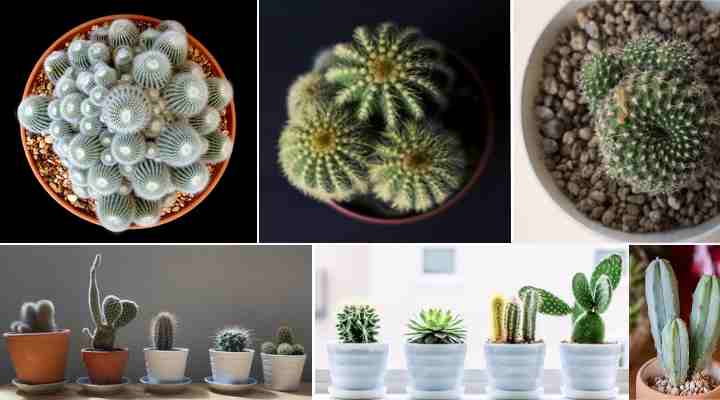
To care properly for your cacti, transplant them as soon as possible after buying them to ensure healthy growth
Plant cacti in a fresh potting mix as soon as you bring them home. Stores rarely sell cactus plants in the best soil, and it’s usually a regular potting soil. Also, you can never be sure how fresh the soil is or if pests are lurking there.
Another reason to transfer your cactus to a new pot is that they may be rootbound. Cacti are sold in small pots that may be too small for the plant. Repotting in a new, slightly larger container allows the roots more room to grow and encourages better soil drainage.
It’s effortless to make a homemade potting soil mix for cacti. Repotting cacti in a fresh, sterile potting mix is the best way to ensure healthy growth with plump, fleshy succulent leaves.
How to Transplant a Cactus in a New Potting Soil
Repot fast-growing cactus plants every two to three years. For slower-growing cactus varieties, repot every three to four years. Choose a pot slightly larger than the current one and make sure it’s got drainage holes at the bottom. A cactus needs repotting when roots poke out the drainage holes.
Here are instructions on how to repot a cactus:
- Remove the cactus from its pot.
- Shake the dirt from the roots and check for brown mushy, or dead roots—trim as necessary.
- Repot the cactus in a new pot with a fresh cactus soil mix.
- Water thoroughly and place the cactus pot in a bright sunny spot.
How to Water a Cactus

To avoid over-watering your cactus, only water it when soil completely dries out
Water cactus plants by thoroughly soaking the soil. Allow all the excess water to drip out the bottom of the pot. Only water the cactus as often as the potting mix completely dries out. In summer, you may have to water a cactus as often as every week.
Cacti are drought-tolerant plants, and they hate over-watering. So, let soil dryness be your guide to watering the plants. The room temperature, sunshine, humidity, season, and type of cactus can affect how often you need to water cactus plants. Avoid the mistake of watering on a set schedule.
Generally, you need to water a cactus every seven to fourteen days in summer. During winter, your cactus plant can go for many weeks without water. Remember that cacti store moisture in their succulent leaves. It’s best to err on the side of caution and water cactus plants less often rather than too much.
Read the complete guide to the best indoor plant fertilizers
Related articles:
